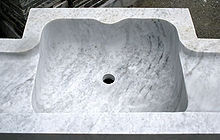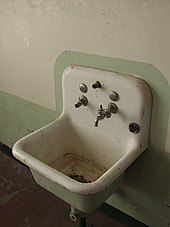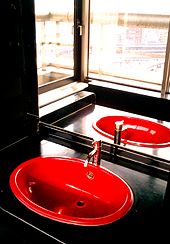sink
A wash basin (in Switzerland : lavabo ) is a container that is concave at the top and has a (usually closable) drain to the sewer system and a fitting for the dosed delivery of hot or cold water . As the name suggests, a wash basin is often used for cleaning (e.g. parts of the body or objects).
history
Even in the early days there were jugs and bowls for washing hands before and after meals . Before there were house connections , a wash basin was generally used .
General

Hand basins do not have a wide rear rim. They usually don't have a molded soap dish, or it is on the side in a corner. The space for the outlet valve is also in a corner, or there is no space for it, so a wall-mounted valve must be used. Hand wash basins are preferred where it is essentially only about hand washing and only little space is available, i.e. especially in toilets and guest toilets. Small hand basins with built-in wall valves, which are primarily intended for pouring away sewage, rinsing hands and rinsing small amounts of sewage, are known as “hand stones” in northern Germany.
Full-size wash basins have a wide rear rim, some with molded soap racks and pre-machined breakable holes (2 to 5) for the inlet fittings. You can find them in bathrooms and toilets, among other things . Double washbasins are also often used in bathrooms, hotel bathrooms and hospital bathrooms.
In commercial washrooms, kindergartens, schools and other facilities, row washbasins are mostly used, which due to their shape are installed directly butting. They are often made of more durable materials such as bruchsichereren ceramic , cast stone or stainless steel made.
There are sinks with cuspidors especially for hospitals, dental practices, but also for upscale hotel construction. There, washbasins with molded wall panels are also used, which can be integrated into the standard hospital tile dimensions.
Sinks in public facilities, especially public toilet facilities or toilet facilities in football stadiums, should sensibly be made of steel instead of fragile porcelain . Such sinks are sold under the name vandal-proof .
Since the beginning of the 21st century, some manufacturers have been offering washbasins that are equipped with special ceramic surfaces that are very easy (if at all) to clean due to the lotus effect .
Recently, massive stone washbasins, made either of marble or hard stone, have increasingly been used in upscale interior design . A certain amount of care and the use of cleaning agents suitable for the particular rock are required.
The drain fitting and the connections for the outlet fitting can be visible or concealed behind a half-shell or column made of the same material as the wash basin. In the disabled area, a built-in siphon should be used to enable a wheelchair to be driven under.
So-called mixer taps are common in Germany . Single-arm mixer taps are increasingly used. In the UK, it is common practice to install hot and cold water taps separately.
Assembly and dimensions
Wash basins are either fastened to prefabricated wash basin stand, on which all fastening points are already specified, or to the wall with special hanger bolts ("WT fastening set"). When installing in front of drywall ( plasterboard ), a plywood board of at least 20 mm thick or a square timber should be attached between the uprights, on which the hanger bolts are securely held.
Sinks with a size of approx. 49 cm × 40 cm to 68 cm × 49 cm and pure hand wash basins with a size of approx. 35 cm × 20 cm to 55 cm × 35 cm are common.
The installation height is approx. 83–86 cm for the upper edge. In private buildings it can of course vary according to the size of the client.
The height of the corner valves should be 57–60 cm, the distance between them 15–20 cm. The drain pipe is usually located between the two corner valves at a height of 52–58 cm.
Angle valves are now usually delivered with sealing rings firmly embedded in the thread. The threads must then not be additionally provided with hemp or sealing tape. The valves are to be screwed in until the sealing rings can no longer be seen in the wall socket, which must then be followed by at least two full turns to secure the valve in place.
Sink cap
Conventional rubber stopper on a perforated screen
Eccentric plug of a washbasin that is operated with a lever mechanism
See also
Web links
Individual evidence
- ↑ Brochure tap water damage through angle valves , Institute for Loss Prevention and Loss Research of the Public Insurers e. V. (IFS), as of December 2018






